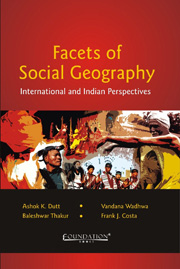Book contents
- Frontmatter
- Contents
- Foreword
- Preface
- Acknowledgements
- List of Contributors
- I Introductory Framework: Allen G. Noble's Contribution to Social Geography
- II Conceptual and Theoretical Basis of Social Geography
- III Social Geography from a Global Perspective
- IV Social Geography in the Indian Context
- V Indian Social Geography: City and State Context
- 24 Health Infrastructure and Healthcare Services in Uttar Pradesh
- 25 Status of Women in Aligarh Muslim University, India
- 26 Social Geographies of Collective Action: A Case Study of India's Chipko Movement
- 27 Sacredscape and Manescape: The Sacred Geography of Gaya, India
- 28 Madurai: A Holy City of Pilgrimage
- 29 Assessment and Dynamics of Urban Growth in the City of Kolkata
- 30 Socioeconomic and Demographic Conditions of the Slums of Hyderabad
- 31 Writings of Mirza Ghalib: A Study in Literary Geography
- 32 Geographic Images of Old Delhi through Literature
- 33 Spatial and Temporal Characteristics of Elite Residential Colonies in Delhi, 1982–2004
- Index
27 - Sacredscape and Manescape: The Sacred Geography of Gaya, India
from V - Indian Social Geography: City and State Context
Published online by Cambridge University Press: 05 June 2012
- Frontmatter
- Contents
- Foreword
- Preface
- Acknowledgements
- List of Contributors
- I Introductory Framework: Allen G. Noble's Contribution to Social Geography
- II Conceptual and Theoretical Basis of Social Geography
- III Social Geography from a Global Perspective
- IV Social Geography in the Indian Context
- V Indian Social Geography: City and State Context
- 24 Health Infrastructure and Healthcare Services in Uttar Pradesh
- 25 Status of Women in Aligarh Muslim University, India
- 26 Social Geographies of Collective Action: A Case Study of India's Chipko Movement
- 27 Sacredscape and Manescape: The Sacred Geography of Gaya, India
- 28 Madurai: A Holy City of Pilgrimage
- 29 Assessment and Dynamics of Urban Growth in the City of Kolkata
- 30 Socioeconomic and Demographic Conditions of the Slums of Hyderabad
- 31 Writings of Mirza Ghalib: A Study in Literary Geography
- 32 Geographic Images of Old Delhi through Literature
- 33 Spatial and Temporal Characteristics of Elite Residential Colonies in Delhi, 1982–2004
- Index
Summary
Mythology and Historical Geography
Gaya, a city in Bihar, is a famous pilgrimage centre. The literal meaning of ‘Gaya’, ‘let's go to another place’, refers to contact with the other realm; it symbolises a destination linking this world of humanity and the world of divinity (ancestral world). According to one of the most authoritative Sanskrit texts on pilgrimage and sacred places, the Tristhalisetu (TS), which means and dates back ‘Bridge to the Three Holy Cities’ circa sixteenth century, of the three pillars of the ‘bridge to the realm of the soul’, Gaya is the eastern most. The others are Varanasi and Prayaga (Allahabad), both along River Ganga in the West. The name ‘Gaya’ was referred to in the earlier Vedic text, the Rig Veda, RV (10.63,10.64), as the name of a sage and writer, while later in the Atharva Veda, AV (1.14.4), Gaya was mentioned as a mystic and sorcerer. The first clear indication of Gaya as a holy place is when it is metaphorically eulogised in the RV (1.22.17)–‘Vishnu crossed this and placed his first foot in three ways: the whole of it is encompassed in his steps’. The treatise Nirukta, NrT (12.19), circa eighth century BCE, explains this passage in two ways. The first, according to Shakapuni, refers to the three steps of Vishnu, viz. the earth, the firmament and the heavens. The second, according to Aurnavabha, refers to the three sacred places called Samarohana, Vishnupad and Gayashirsh.
- Type
- Chapter
- Information
- Facets of Social GeographyInternational and Indian Perspectives, pp. 502 - 525Publisher: Foundation BooksPrint publication year: 2012
- 1
- Cited by



